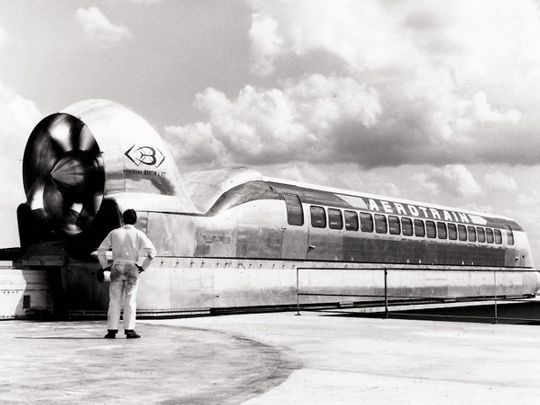In search of the lost train
Beauce #Beauce
 Intercity Aérotrain I.80 Image Credit: The Kurator
Intercity Aérotrain I.80 Image Credit: The Kurator
The Aérotrain was part of the modernist utopia of the 1960s and 70s, supported by the pow-ers that be, when the right wing of the Pompidou government was enthusiastically embracing the most avant-garde modernity. Engineer Jean Bertin represented French engineering know-how, combining technological innovation with stylised beauty of form. A technical director at Snecma, he left the plane engine manufacturer to start his own industrial research company, where he designed a train sitting on a cushion of air running along a monorail propelled by a giant fan behind the car. So that its “organs” were not in contact with the track. The vehicle ran along on a pre-stressed concrete viaduct. Later, the fan would be replaced by a motor capable of reaching 430 km/h. In 1968, to present his invention, Jean Bertin ordered the construction of an experimental 18-kilometre track between the towns of Saran and Ruan in the Loiret region.
An explorer of the secret roots of the contemporary world, the writer Philippe Vasset wonders along the Aérotrain track as though it were an old friend, this ugly viaduct that gave rise to the foundations of his literary art. For as long as he can remember, he has wound along its narrow platform, looking at life from the bottom of this raised viewpoint, observing the world from a certain distance – such as would a writer being careful to avoid the trap of solipsism. The 7-metre high concrete bridge runs through the villages of Cercottes, Chevilly, Artenay and Ruan, the Orléans Forest, the Beauce Plateau, then alongside the Nationale 20 highway and briefly parallel to the Paris-Bordeaux railway. A prototype designed as a high-speed link between Paris and Orléans and then as the line between Cergy-Pontoise/La Défense, the Aérotrain caught the eye of the Saudi Arabians, who considered it for linking Mecca to Jeddah, whilst the South Africans saw it as running through the townships to link Johannesburg and Pretoria. This flying pipedream evokes the best of modernist inventiveness, like the creations of Robert Mallet-Stevens, Jean Prouvé or Jean Dubuisson, with this observable functionality of speed at a great height, which fully restores a space placed within the reach of travellers overlooking the landscape.
Philippe Vasset situates his coming of age in the light of the ruins of the Aérotrain, at a time when it was just becoming a failure, sacrificing stylised modernity in the name of austerity. In 1974, the new President of France, Valéry Giscard d’Estaing, with the support of his Minister of the Interior Michel Poniatowski, buried the Aérotrain – it was too expensive and unsuitable – in order to launch the high-speed TGV adventure, known as the turbotrain at the time. Unable to withstand this blow, Jean Bertin died the following year. His Morvan accent, his faith in bold creations created in the service of the public good, a form of entrepreneurial generosity incompatible with the bureaucratic pragmatism and coldness of financial capitalism, was no longer in accord with the spirit of the time. Now the TGV is everywhere, but it does not run on a raised platform. Its aerodynamic shape does not have the one-of-a-kind radiance of the Aérotrain. A hybrid utopia, half aeroplane, half train, a vehicle with old-fashioned beauty, which appeared for no other reason than its sole presence before ultimately disappearing, this UFO belongs to a bygone golden age of technology. A time when when enigmatic poetry could guide inventors in the mysterious world of suspended shapes.